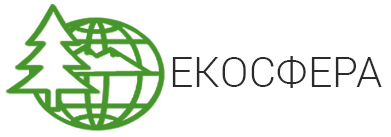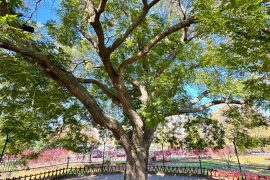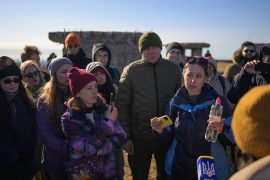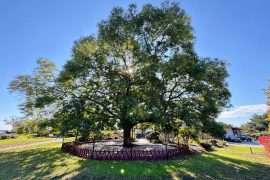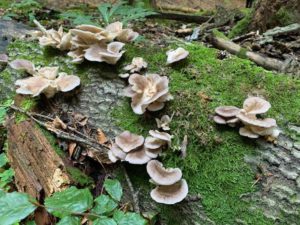
Old tree trunks, trees that are dying or are already dead, tree trunks and branches that have fallen to the ground, form one of the richest and, so far, underestimated habitats for biodiversity in Europe.
Deadwood plays a key role in maintaining forest productivity, natural regeneration, biodiversity conservation, and increasing resilience against the climate change. However, deadwood management is a relatively new concept in Romania and Ukraine that has only been promoted since the 2000s. Dead or fallen trees provide the habitat of about 30% of insects living in the forest, they can be home to various species of birds and mammals, they accumulate carbon from the atmosphere through the food chain and their decomposition is a source of increased soil fertility.
As part of the RESFOR project, Ukrainian and Romanian scientists are exploring the benefits of increasing the amount of deadwood in the forest to increase the resilience of forest ecosystems. The partners in the project are environmental organizations WWF-Romania and the NGO “Ecosphere”, as well as scientific institutions – UkrRIMF in Ivano-Frankivsk and the University Stefan cel Mare in Suceava.
To date, UkrRIMF scientists have established 20 circular sample plots with an area of 500 m2 each in the forest of the Drestunka Velyka river watershed, which is located in the Krasnytsia forestry unit of the Verkhovynske State Forestry Enterprise in Prykarpattia in managed forests. At the sample plots, a complete description and assessment was performed, the height and diameter of the trunk of each tree were measured, the cores were drilled, and the amount of deadwood on the transects was determined.
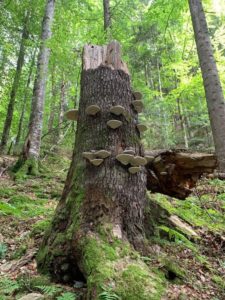 “Biodiversity assessment was performed at 4 1×1 m sampling sites, which are located at a distance of 6.31 m from the sample plot center on 4 cardinal directions (N, E, S, W). Due to the end of the vegetation season, the diversity of herbal layer is low. We found Galeobdolon luteum, wood sorrel, lady fern, hedge bedstraw, mosses. After processing the field data, we plan to show the difference in phytodiversity depending on the structure of the stand and fellings that was carried out there, ”explains Ivanna Danilova, a junior researcher at UkrRIMF.
“Biodiversity assessment was performed at 4 1×1 m sampling sites, which are located at a distance of 6.31 m from the sample plot center on 4 cardinal directions (N, E, S, W). Due to the end of the vegetation season, the diversity of herbal layer is low. We found Galeobdolon luteum, wood sorrel, lady fern, hedge bedstraw, mosses. After processing the field data, we plan to show the difference in phytodiversity depending on the structure of the stand and fellings that was carried out there, ”explains Ivanna Danilova, a junior researcher at UkrRIMF.
“We assessed lying and standing deadwood. The assessment of standing deadwood was carried out within the assessment of the stand on the sample plot. For each tree, the diameter of the trunk at a height of 1.3 m, the stage of decomposition and the corresponding code (according to the agreed methodology) were indicated”, adds the senior researcher of the UkrRIMF, Ph.D. Taras Yunyk. And he continues: “We described also each part of lying deadwood within each sample plot to show it later on a 3D model”.
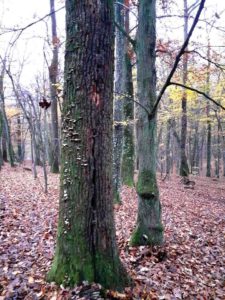 Transect assessment was performed to calculate the volume of deadwood on each according to the formula of Bohl and Brandi. Within the project, it is planned to establish 20 more sample plots in virgin forests.
Transect assessment was performed to calculate the volume of deadwood on each according to the formula of Bohl and Brandi. Within the project, it is planned to establish 20 more sample plots in virgin forests.
The emphasis of research on the deadwood role in the resilience of forest ecosystems against climatic conditions is given to dendrochronology. For this purpose, mostly older trees of typical Carpathian species – spruce, beech, fir – were selected to take wood cores. “We expect to identify cyclical links between annual ring width and meteorological factors – temperature, humidity – over the past 40-60 years, or to identify the impact of stand structure on tree growth during ontogenesis”, explains Ph.D. Taras Parpan, leading researcher at the UkrRIMF.
Similar studies are being conducted by Romanian colleagues at the University of Suceava in the Romanian Carpathians. The first results can be expected in the beginning of 2021.
Funded by the European Community through the European Neighborhood Instrument, Joint Operational Program Romania-Ukraine 2014-2020, the project has a duration of 18 months (January 2020 – June 2021). The specific objectives, activities and expected results of the project are related to the target area of the project in Romania (Maramures and Suceava counties) and Ukraine (Ivano Frankivsk and Zakarpattia regions).
The value of the project is 324942,5 euros (1562973,425 lei), of which the European Union contribution is 292448,25 euros (1406676,08 lei). EMS-ENI code: 2soft/1.2/13.
For more information we can be contacted:
Oksana Stankiewicz-Volosyanchuk – Communication Expert, [email protected], +38
